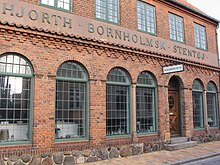Hjorth's factory
Hjorths Fabrik was a ceramic factory in the capital Rønne on the Danish island of Bornholm , which is now used as a museum under the same name. It is located at Krystalgade 5. The museum is operated as a subsidiary of Bornholms Museum .
History of the factory
The founder Lauritz Adolph Hjorth acquired the first part of the building complex, which is now used as a museum, in 1862 for 2,000 Rigsdaler , to live there with his wife Agnethe Marie Hjorth (née Wolffsen) and finally eleven children together and to run a ceramic factory. Hjorth previously had an apprenticeship with the master potter Edv. Sun finished and then worked in various ceramic workshops in Europe, including in Schumann's porcelain factory in Berlin, Saxony, on the Rhine, Switzerland and northern France. After his return to Bornholm in 1859, now 25 years old, he set up a small workshop in part of his parents' house until he relocated his business to the newly acquired house on Krystalgade. In 1862 he married Agnete Wolffsen, the daughter of the founder of a faience factory .
In the first workshop in his parents' house, Hjorth first made water coolers, milk jugs, butter coolers, tobacco boxes, match boxes, planters and other utensils. The growing production soon served not only the local demand, but was also exported to other parts of Denmark and eventually to other European countries. As early as 1871, the company was operated in a two-story building with ten workplaces. In 1874 a neighboring property was bought in order to be able to expand production and to create space for the lathe workshop, storage room, packing room and also a small garden. In 1875, Hjorth already employed 25 lathe operators and painters. His first price list with 115 numbers came from this year. Immediately after the introduction of the new Danish currency in kroner, the krona divided into 100 ore, Hjorth already advertised with an illustrated catalog with 457 numbered goods. In 1883 there were already twelve dealers in Denmark, one in Sweden, one in England (which alone took 15% of production), five in Germany and one on the island of St. Thomas. At that time Hjorth's factory produced 45% knick-knack items such as small figures, 34% antique vases in miniature format and approx. 20% larger vases. The 1885 catalog already names 643 different products. In addition to the production of purely everyday objects, the production of sophisticatedly decorated work had already become more and more important. This also included vases with a classicist decor, which, although classicism had generally gone out of fashion since the 1840s, continued to be in demand until the end of the 19th century. Both copies of ancient originals and vases painted with local motifs, such as the Hammershus castle ruins in Bornholm, were made . The production of antique vases was supplemented by Art Nouveau vases around the turn of the century . In 1919 56 people were employed. However, the dealer network that was supplied by Hjorth had changed significantly during the First World War. From 1920 sales and the number of employees fell. In 1927 only 27 workers could be employed. Production had shifted back to the manufacture of utensils, albeit for high demand, such as table service. Goods were stamped with a deer (Danish Hjorth) as a brand. In 1951 50 employees were employed again. From 1951 a decline began again and almost without exception the production took place only for the store sale and the dispatch to the end user. Merchants no longer accepted the goods from Hjorth's factory. In 1977 only 15 people were employed, five of which were family members of the 3rd and 4th generation.
The local clay from Sose and Onsbaek with a typical reddish-yellow color was used as the raw material. For later figurative representations on the vases, insofar as they were not hand-painted, decals were obtained from German factories from around 1870 onwards. In the years between 1870 and 1880, Hjorth paid his painters and lathe operators a piecework wage that fluctuated between 15 and 22 kroner at 60 hours a week, while the usual hourly wages at that time were around 22 to 25 ore. The chief painter, who received a somewhat higher fixed wage, was excluded from this.
After Lauritz Adolph Hjorth's death in 1912, the factory was run jointly by his sons Peter and Hans until 1932, from then on by Peter Hjorth alone. His heirs Adolph and Erik Hjorth took over in 1959 after the death of Peter Hjorth. From 1983 Marie and Ulla Hjorth were able to continue the factory for a few years.
History of the museum
On April 1, 1993, Hjorth's factory was sold to Bornholms Museum with financial support from Bornholmes Amt and the city of Rønne. Financial subsidies from the European Union and the Danish Ministry of Education followed later. In the same year the building was restored to open it as a "working museum". The aim was not only to show the history of Hjorth's factory, but also the entire history of Bornholm ceramics from around 1700. At the same time, the workshops were restored to work, so that on weekdays visitors can watch a modest ceramic production by four ceramists.
tour
The tour includes 10 stations: ball mill, feasting, material store, turning workshop, clay foundry, storage room, glaze production, glaze application, old oven, electric and gas oven. The ensemble of buildings, consisting of six different houses, is grouped around a garden. In the entrance area there is not only the cash register and a small room for contemporary ceramic art, but also a small museum shop.
literature
- Peter Hjorth, Marianne Ertberg, Henrk Vensild: L. Hjorth - A ceramic company in Rönne. Ed .: Bornholms Museum, 2nd edition 1995, ISBN 87-88179-21-4
Web links
Coordinates: 55 ° 6 ′ 9.1 ″ N , 14 ° 41 ′ 49.3 ″ E


